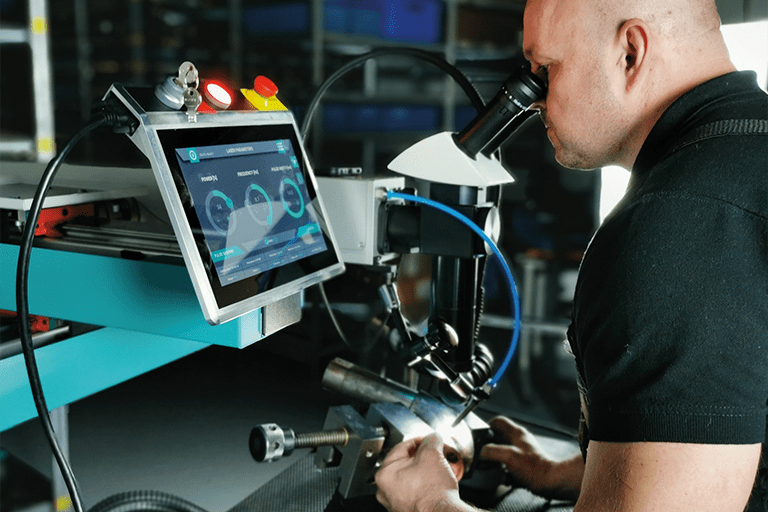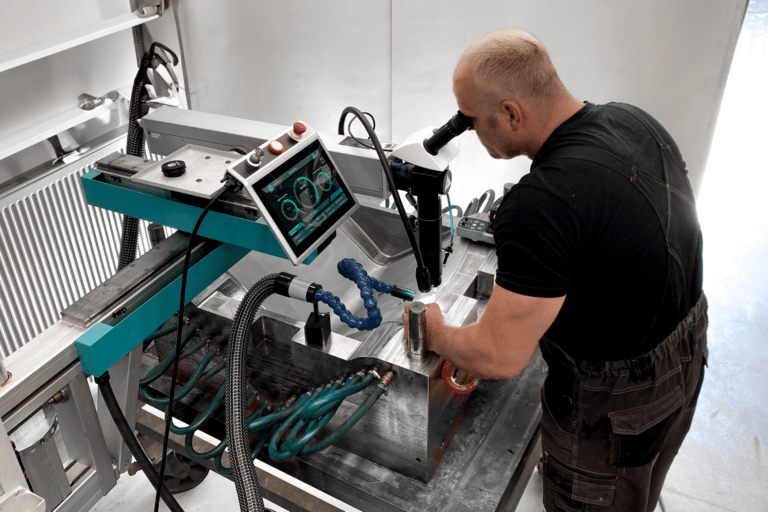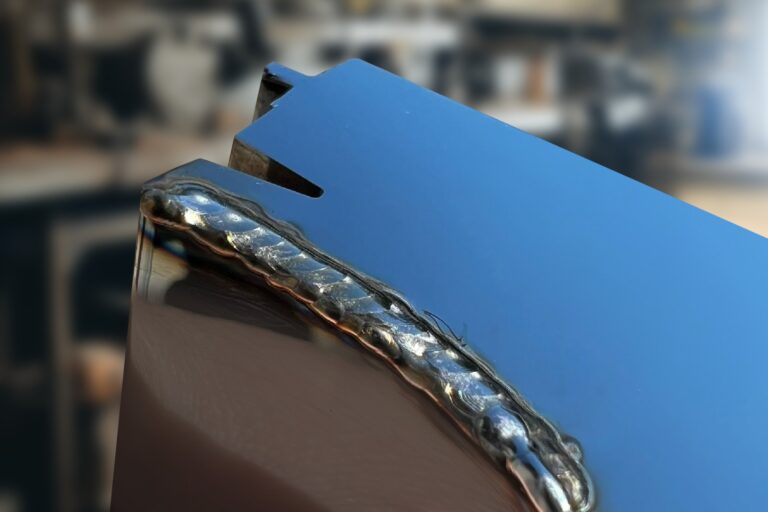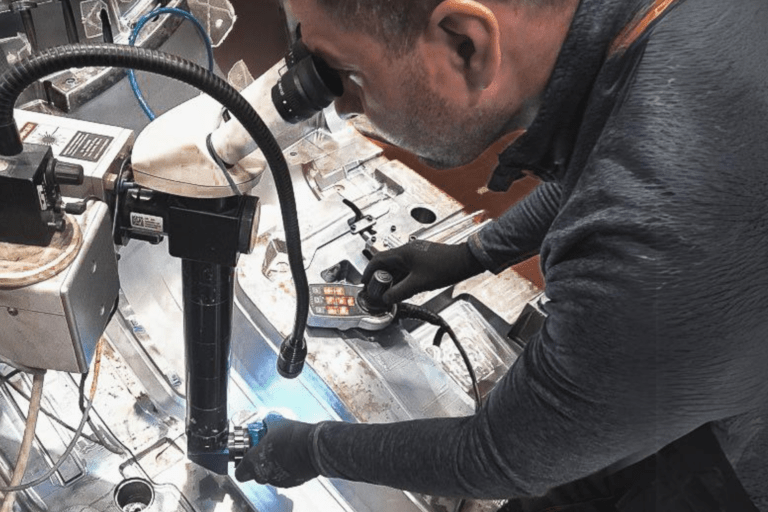Laser welding and cladding
We provide professional welding and cladding services, encompassing the repair and modification of injection molds, pressure molds, cutting dies, and other tools. Our modern laser systems and TIG welders ensure precision and durability of our work. The machinery in our workshops includes both HTS Mobile and ECO laser welders, as well as ROBOLASER technology.
01.
LASER CLADDING
When using metal powder for laser cladding, the laser focuses its energy on a specific area of the workpiece, causing localized heating and melting of the surface. At the same time, metal powder is delivered to the laser’s focal point in a gas shield. As the laser heats the surface, the metal powder also melts, creating a strong bond with the workpiece surface. This process results in a durable and homogeneous surface after excess material is removed.
01.
LASER CLADDING
When using metal powder for laser cladding, the laser focuses its energy on a specific area of the workpiece, causing localized heating and melting of the surface. At the same time, metal powder is delivered to the laser’s focal point in a gas shield. As the laser heats the surface, the metal powder also melts, creating a strong bond with the workpiece surface. This process results in a durable and homogeneous surface after excess material is removed.
02.
LASER WELDING
Laser welding is an advanced method of joining materials that utilizes a concentrated beam of laser light. Due to its high precision, this process is widely used across various industries.
Laser welding involves melting welding wire by directing a highly concentrated beam of light with very high power density to the welding location. The process typically utilizes a laser beam with a wavelength of 1067 nm generated in a synthetic neodymium-doped yttrium aluminum garnet crystal (Nd:YAG). This method is particularly effective for welding small, delicate components that are sensitive to deformation from overheating. Laser welding also minimizes the risk of weld sinks and distortions.
The unmatched precision compared to other welding methods, the ability to create very thin weld seams, and the minimal thermal impact significantly reduce both the time and costs of subsequent post-processing.
02.
LASER WELDING
W laserowych systemach spawalniczych, intensywna wiązka laserowa jest przeważnie kierowana na spawany obszar za pomocą elastycznych światłowodów. W tym miejscu, dzięki zastosowaniu zaawansowanego układu optycznego energia lasera jest skupiana w niewielkim punkcie. co prowadzi do lokalnego podgrzewania i topienia materiału obrabianego, umożliwiając skuteczne łączenie ze sobą spajanych elementów.
03.
TIG WELDING
TIG welding technique (Tungsten Inert Gas) utilizes a non-consumable tungsten electrode and a neutral gas shield. Heat required for welding is generated by an electric arc between the electrode and the material. The process is predominantly manual, though automated versions exist.
TIG welding is widely acclaimed for its speed, versatility, and intuitive application. This method is suitable for welding high-quality alloys such as aluminum, stainless steel, acid-resistant steel, and titanium alloys. A distinctive feature is that after welding, there is no need for extensive mechanical post-processing. Another advantage of this method is the ability to weld very thin sheets, even as thin as 0.5 mm, with precise control over the welding process.
03.
TIG WELDING
TIG welding technique (Tungsten Inert Gas) utilizes a non-consumable tungsten electrode and a neutral gas shield. Heat required for welding is generated by an electric arc between the electrode and the material. The process is predominantly manual, though automated versions exist.
TIG welding is widely acclaimed for its speed, versatility, and intuitive application. This method is suitable for welding high-quality alloys such as aluminum, stainless steel, acid-resistant steel, and titanium alloys. A distinctive feature is that after welding, there is no need for extensive mechanical post-processing. Another advantage of this method is the ability to weld very thin sheets, even as thin as 0.5 mm, with precise control over the welding process.
Laser Welding vs TIG Welding
The choice between TIG welding and laser welding largely depends on the application’s requirements.
Laser welding is preferred when the highest precision, speed of process, and minimal heat-affected zone are priorities. Laser technology excels especially in hard-to-reach areas and provides significantly higher homogeneity in welded joints.
TIG welding is more versatile and suitable for a wide range of applications, especially where materials are thicker and precise process control is crucial. It’s also worth noting that the initial investment costs, including the purchase of the welding equipment, are significantly lower compared to laser systems.
Undoubtedly, laser welding and cladding represent more advanced processes, but it’s essential to tailor the technique to the specific application requirements.
Our Competitive Edge
MOBILITY
With our mobile laser systems, we can provide comprehensive services directly at the client’s location, which is particularly beneficial for large-scale components that are difficult or impossible to transport. Moreover, working on-site minimizes production downtime.
EXPERIENCE
Our extensive experience allows us to deliver services at the highest level, with meticulous attention to every detail. Continuous interaction with our technology and production departments enables us to optimize each order, treating each project with a personalized approach at Laserpoint.
FLEXIBILITY
Our diverse and well-equipped welding facility, along with a stocked inventory of consumables, allows us to handle every order efficiently while maintaining the highest quality standards and ensuring quick turnaround times.
TECHNOLOGY
We utilize advanced laser welders such as HTS Mobile, ECO, ROBOLASER, and Piggy Welder, enabling us to achieve fast and precise results in welding and cladding processes. As a member of the SUMARIS GROUP, we have access to regularly tested and technologically advanced equipment.
Services
branchLaser welding
Laser cladding 3D, 2D
Engraving on metal
3D metal printing
+48 523 070 308
bydgoszcz@laserpoint.pl
Grunwaldzka 207 Street
85-451 Bydgoszcz, POLAND
branchLaser welding
Laser cladding 3D, 2D
Engraving on metal
3D metal printing
+48 604 195 915
warszawa@laserpoint.pl
Trakt Brzeski 122 Street
05-077 Warszawa, POLAND
branchLaser welding
Laser cladding 3D, 2D
Engraving on metal
3D metal printing
Additive manufacturing
+48 728 911 650
gliwice@laserpoint.pl
Pszczyńska 237 Street
44-100 Gliwice, POLAND
branchLaser welding
Laser cladding 3D, 2D
Engraving on metal
3D metal printing
Texturing
+48 577 232 628
biuro@laserpoint.pl
Graniczna 22 Street
62-002 Złotniki, POLAND
branchLaser welding
Laser cladding 3D, 2D
Engraving on metal
3D metal printing
Texturing
+380 955 394 750
m.kyrychemko@sumaris.com.ua
Haharina Ave, 31a Street
6100 Kharkiv, UKRAINE




